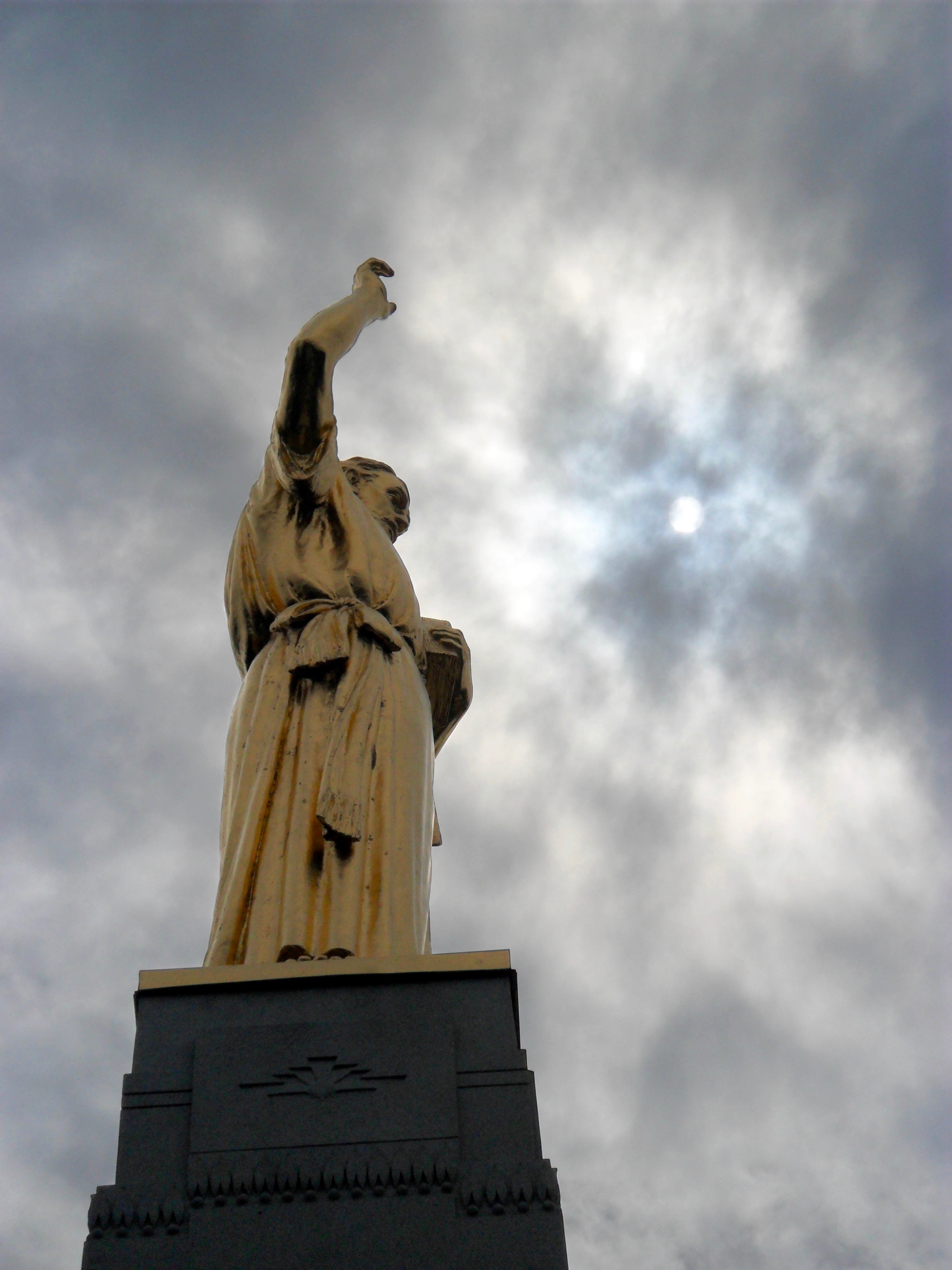Author: Marc Bohn
-
The Power of a Collective Fast
During General Conference last weekend, President Russell M. Nelson called for a worldwide fast on Good Friday (April 10) to “prayerfully plead for relief from this global pandemic.” Notably, this is the second collective fast in less than two weeks that Nelson has organized to petition God to alleviate “the physical, emotional and economic effects”…
-
Welcome to Guest Blogger Michael Haycock
Times & Seasons is pleased to welcome Michael Haycock as our latest guest blogger. Michael was primarily raised in Northwest Ohio and served his mission in Argentina. After graduating with a B.A. in political science from Yale University, he received an M.A. in religion (American religious history) from Claremont Graduate University, where he wrote his…
-

Call for Proposals: Mormon Scholars in the Humanities Conference
Mormon Scholars in the Humanities (MSH) invites proposals for its 2020 annual conference. The conference topic this year is Aesthetics, and papers or panels organized around the theme are encouraged. The deadline for submitting a proposal abstract is this Friday, November 1. The culture that surrounds the Church of Jesus Christ of Latter-day Saints has had…
-
Times & Seasons Re-Welcomes Bryan Hickman
Times & Seasons hopes you will join us in welcoming our latest guest blogger, Bryan Hickman, for his guest-blogging stint with us (see here for his prior posts). Bryan is a semi-reformed Utah Mormon (whatever that means) doing his best to rein in the knee-jerkedness of his worldview (whatever that means). He went to school…
-
Times & Seasons Welcomes Levi Jones
Times and Seasons hopes you will join us in welcoming our latest guest blogger, Levi Jones. Levi is an attorney with the U.S. Department of Commerce, where he handles general litigation matters. Prior to joining Commerce, Levi worked for several years as a corporate lawyer for a D.C. area firm. Levi earned his law degree…
-
10 Questions with Spencer Fluhman
Continuing our work with the 10 Questions team, we are pleased to present Kurt Manwaring’s interview with Spencer Fluhman, Director of the Neal A. Maxwell Institute for Religious Scholarship at BYU and an editor of “To Be Learned is Good: Essays on Faith and Scholarship in Honor of Richard Lyman Bushman.” Manwaring and Fluhman cover a wide…
-
10 Questions with Jonathan Stapley
As part of our work with the 10 Questions team, we will be posting later this week on Kurt Manwaring’s upcoming interview with the Maxwell Institute’s Spencer Fluhman. In the meantime, however, we thought we would highlight a great interview 10 Questions recently posted with Jonathan Stapley, bloggernacle regular and author of “The Power of Godliness:…
-
Guest Post: Seminary Assessments and Americacentrism
James Holt lives in Manchester, UK and is Senior Lecturer in Religious Education* at the University of Chester. This involves training teachers to teach Religious Education in schools, as well as aspects of education for teachers training to teach in a secondary (11-18) school. James is also Chair of Examiners for GCSE Religious Studies for…
-

A Mormon Image: From on High
The title of and inspiration for this photograph of the Moroni statue atop Hill Cumorah in Palmyra comes from the text of Parley P. Pratt’s hymn “An angel from on High” (Hymns 13).
-
T&S Welcomes Guest Blogger Michelle Lee
Times and Seasons hopes you will join us in welcoming our latest guest blogger, Michelle Lee. Michelle is a licensed therapist practicing in the San Francisco Bay Area. She currently works full-time for her local school district, providing mental health counseling and crisis management services to adolescents and their families, and also has a private…
-

A Mormon Image: The Kids Table Easter
I spent a lot of years at the kids table when I was young. Family dinners were a big deal. My grandmother lived for them. She was an excellent cook and a hostess extraordinaire. She would recite poetry and lead her guests in singing a few songs. She would also use her seating chart to try…
-
Reviving Our “A Mormon Image” Photo Series
We’ve decided to revive our long dormant photo series “A Mormon Image,” which features photos and other images that carry meaning for us because they resonate with our “Mormonness.” As part of this, we’d like to issue a renewed call for photographs to be considered for inclusion in the series. What qualifies as a Mormon image?…
-
Welcome to Guest Blogger Carole Turley Voulgaris
Times and Seasons is pleased to welcome Carole Turley Voulgaris as our latest guest blogger. Carole recently completed her PhD in transportation planning at UCLA and will be joining the transportation engineering faculty at Cal Poly San Luis Obispo this winter following her upcoming maternity leave. For the time being, she lives in the Seattle area…
-
Guest Post: What Can LGBT Mormons Hope For?
A year and a half ago, I invited John Gustav-Wrathall, president of the support group Affirmation: LGBT Mormons, Families & Friends, to share his thoughts on the Church’s new policy affecting LGBT members and their children (see All Flesh from December 2015). Diverging responses to this post gave rise to the idea of hosting a conversation on the blog about…
-
Terryl Givens on What It Means to Sustain
Below is a letter Terryl Givens recently wrote on what it means to sustain Church leadership. It is an outgrowth of an actual correspondence between Brother Givens and a friend, and is posted with Givens’ permission. The friend holds strong feelings about recent changes made to the Church Handbook of Instruction and had asked Givens…
-

Guest Post: All Flesh
John Gustav-Wrathall is the newly-elected president of Affirmation: LGBT Mormons, Families & Friends, an international organization founded in 1977 to support LGBTQ/SSA Mormons and their families, friends and Church leaders. Following his election, I invited Gustav-Wrathall, a personal friend, to draft a post on his thoughts about the new policy, his interactions with Church leaders, and…
-
Welcome to Guest Blogger Dave Evans
Times and Seasons is pleased to welcome David K. Evans as our latest guest blogger. Dave is a Senior Economist in the Chief Economist’s Office for the Africa Region of the World Bank and holds a Ph.D in economics from Harvard University. In the wake of last year’s Ebola outbreak, Dave has also become talk radio and…
-
DC Institute Class
Thomas B. Griffith (D.C. Circuit Court judge and former BYU General Counsel, Senate Legal Counsel, Bishop and Stake President) is teaching an institute class at the Chevy Chase building this fall on early Church history, with a focus on “Joseph Smith as Everyman.” The class starts Tuesday, September 2nd at 7pm and will run every Tuesday night throughout the fall.…
-
Sounding the Secularist Alarm at BYU
Ralph Hancock has a provocative article in the March edition of First Things in which he raises concerns about the specialization/secularization he sees occurring at Brigham Young University: “For some decades, BYU had managed a compromise between the academic mainstream and its own aspiration to a distinctive mission. [While encouraging excellence in the scholarly communities in which we…
-
Do exemptions from the ACA’s ‘contraception mandate’ threaten religious liberty?
In March, the Supreme Court will hear a pair of cases on whether for-profit employers can claim a religious exemption to the Affordable Care Act’s requirement that employer health plans cover contraceptives without any out-of-pocket expense because the use of contraceptives violates their owners’ religious beliefs. In a Washington Post op ed this week, Fred…
-
A Look at the Political Affiliations of Some Prominent Members
A friend recently drew my attention to a new website that catalogs Utah voter registration data in a searchable format that was purportedly purchased from the Herbert administration. After checking the voter registration data of a few friends and acquaintances, I thought it would be interesting to identify the party registrations of some prominent members of…
-
New Missionary Policy
“I am pleased to announce that, effective immediately, all worthy and able young men who graduated from high school or its equivalent regardless of where they live will have the opportunity of being recommended for missionary service beginning at the age of 18 instead of age 19…. today, I am [also] pleased to announce that…
-
The Waylaying of Brandon Flowers
Despite being unfairly ambushed on the subject of religion prior to a recent performance on the Norwegian-Swedish television show Skavlan, Brandon Flowers admirably stood up for his faith, shying away from neither the battery of questions on his Mormonism by Norwegian journalist Fredrik Skavlan and others nor the full-on frontal assault on Joseph Smith, the Book of Mormon and God by surprise…
-
Kiewit Power Constructors Co. Gets ‘Jimmered’
Case Background: Kiewit Power Constructors Co. contested a National Labor Relations Board decision to reinstate two fired electricians for threatening workplace violence. Kiewit Power had warned the electricians that their breaks were too long, and that they may need to take them in a different location. The electricians responded by saying things would “get ugly” if they…
-
Elder Oaks Testifying Before Congress Today
For those interested, Elder Dallin H. Oaks is testifying right now before the Senate Finance Committee on tax reform, specifically incentives for charitable giving. He is testifying at the request of Senator Hatch.
-
Sam Brunson Joins Times & Seasons
Times & Seasons is happy to announce that Sam Brunson has agreed to join our happy blogging family as a permanent contributor. For those unfamiliar with Sam, the introductory post on him can be found here and his posts to-date are available here.
-
Times & Seasons Welcomes Sam Brunson
Times & Seasons is excited to introduce Sam Brunson as our latest guest blogger. Sam grew up in the suburbs of San Diego and served a Brazilian mission what seems like a millennium ago. He went to BYU as an undergrad and found that a freshman saxophone performance major made his eventual English major look…
-
Times & Seasons Welcomes Brad Strum
Times & Seasons is excited to introduce Brad Strum as a guest blogger. Brad lives and works in the DC area as an economist, where he has been since earning a Ph.D. in economics at Princeton University. Before grad school, he served in the Russia, Rostov-na-Donu mission and attended Brigham Young University, earning undergraduate degrees…
-
Notable Race-Related Changes to Footnotes and Chapter Headings in the Standard Works
Marvin Perkins is a Latter-day Saint music producer who is currently the Public Affairs Co-chair for the Genesis Group and who has worked to nurture understanding between African Americans and Latter-day Saints and attack misconceptions (see our 12 Questions series with Brother Perkins from 2009). This morning, Brother Perkins circulated the following email to his…
-
Unique Outreach by the Rochester Stake
This week, the Rochester Stake in New York is sponsoring a special performance of Carol Lynn Pearson’s Facing East, to be followed by a fireside featuring a discussion led by the Rochester Stake President. Notably, the performance is being directed by Jerry Argetsinger, who was the long-time director of the Hill Cumorah Pageant throughout the…
